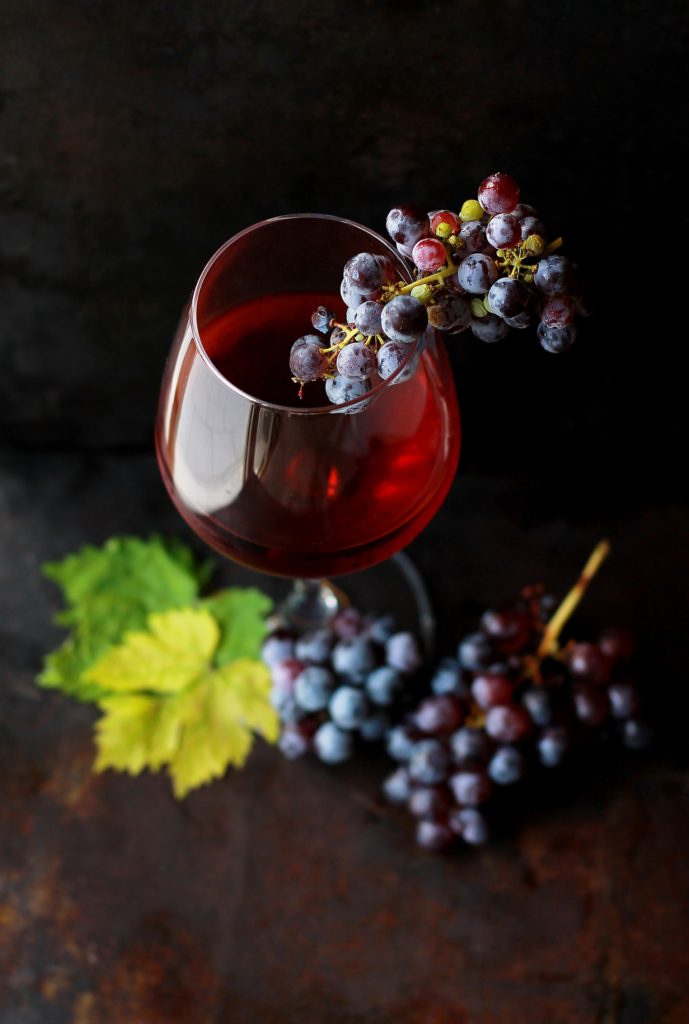Today I give you an insight of Beaujolais’s wine GAMAY. Internationally, black Gamay with white juice is not very widespread. Gamay is a red Beaujolais grape par excellence since 60% of the Gamay cultivated in France comes from this vineyard. It is also found in Burgundy (Bourgogne Passe-Tout-Grains, Bourgogne Grand Ordinaire), in the Loire Valley (Coteaux du Vendômois), in Auvergne, in the South-West and in the Savoie vineyards. The Gamay also produces rosé wines (rosés from the Loire, Gris de Toul from the Moselle). Globally, it is widespread in Italy (Valle d’Aosta) and Switzerland (cantons of Valais, Vaud and Geneva). Gamay is also cultivated in Spain, Portugal, Romania, Bulgaria and Australia.
Formerly widely present throughout Burgundy, it acquired its bad reputation when it was banished from the Côte d’Or by an edict from the Duke of Burgundy Philippe le Bold. The latter, upset by the coarse and rustic character of Gamay wines – then produced in large quantities in the plains near Beaune (land suitable for a qualitative expression of this grape variety) – ordered his subjects to eradicate this vile grape variety of Burgundy. The “very desloyaut plant named Gaamez” is then eradicated in favor of pinot noir. But if his death sentence is sounded in Burgundy, Gamay is still cultivated elsewhere; in the 19th century, it was common in Auvergne, Loire, Center and even in the North-East thanks to its agronomic qualities which made it possible to exploit it at the limit latitude of vine cultivation. Before the invasion of phylloxera, it was even one of the most widespread grape varieties, occupying nearly 10% of the French wine-growing area (around 150,000 ha). Currently, it ranks 7th among red grape varieties and around 80% of the world production of Gamay is in Beaujolais.

Gamay and Beaujolais are bound. However, there is no certainty that the Beaujolais region is the original homeland of this grape variety. It is now believed that his “parents” met more in Burgundy after Gouais B was introduced to central Europe by the Huns in the 4th century. But the question of its exact origin remains unanswered. If it adapts to all soils and can produce in abundance, it has in any case found its Promised Land on the Beaujolais mountains, especially in the north on land of granite origin. Particularly suitable vinifications have been developed there, including the so-called Beaujolaise vinification, semi-carbonic in whole bunches, which expresses the aromas and flavors of Gamay particularly well. It thus gives generous, fine and light wines which lack neither sap nor bouquet (raspberry, spices). Le Gamay est le seul cépage rouge autorisé pour les AOC du Beaujolais (des cépages accessoires sont autorisés dans une limite de 15% mais ce sont des blancs).
The area exploited has been relatively stable for 200 years since, according to the Victor Vermorel ampelographer, it was 17,700 ha in 1824 and 25,500 ha in 1881 (Les Vins du Beaujolais, du Mâconnais and du Chalonnais, 1893). However, it should be noted that tests have been carried out recently with new grape varieties, the first of which is Gamaret, born from a cross between Gamay and Reichensteiner, and which is now in the French catalog of authorized grape varieties since 2010. This one, more developed in Switzerland, presents qualities (structured and rich wines, resistance to rot) which could allow its extension in the Beaujolais vineyard in the future.
Gamay is the only red variety authorized for Beaujolais AOCs (accessory varieties are authorized up to a limit of 15% but they are white). The area exploited has been relatively stable for 200 years since, according to the Victor Vermorel ampelographer, it was 17,700 ha in 1824 and 25,500 ha in 1881 (Les Vins du Beaujolais, du Mâconnais and du Chalonnais, 1893). However, it should be noted that tests have been carried out recently with new grape varieties, the first of which is Gamaret, born from a cross between Gamay and Reichensteiner, and which is now in the French catalog of authorized grape varieties since 2010. This one, more developed in Switzerland, presents qualities (structured and rich wines, resistance to rot) which could allow its extension in the Beaujolais vineyard in the future.
Unlike other grape varieties, Gamay is greatly influenced by its terroir, climate and driving conditions and can therefore vary enormously from one region to another, in terms of its vegetation. Rather not very vigorous, but very fertile (2 to 2.5 bunches per eye), it is particularly difficult to drive. It therefore requires a short waist. A variety which buds very early and is cultivated in a sometimes harsh climate, it compensates for the risk of frost by good fertility of the counter-buds and the production of numerous grapillons (which also explains why its yields can sometimes be exaggerated). Its vegetative cycle is short (7 days less than Merlot), with the harvest generally taking place between the end of August and the end of September, depending on the vintages and the terroirs. Solid and resistant variety, not very demanding, Gamay remains however sensitive to gray mold, dead arm disease, wood diseases, grape berry moths and yellowing edges. It is very prone to millerandage if the rain and / or the cold arrive at the time of flowering. It does not like hot climates, which cause it to ripen too quickly and toast the bunches if the sun is too strong. If you want to curb its yields, you have to give it very careful care.
We will distinguish between pre-Christmas wines (futures) and wines after Easter. The former can be pleasant when they are good: they are not very colorful but have beautiful ruby color, brilliant and limpid; with a characteristic nose of small red fruits (strawberry, raspberry, cherry), often complemented by notes of “English candy” and banana; fruity, lively and thirst-quenching on the palate, Beaujolais and Touraine primeur or nouveau are thirst-quenching wines that one can take pleasure in rediscovering once a year. The latter, when they originate from the great granite terroirs of the Beaujolais vintages, can then be great silky, complex and distinguished wines, always with this great “drinkability” and digestibility; delicious when ripe, they can (and sometimes must) wait 2 to 10 years in bottle depending on the vintage.
Do you know all the Beaujolais vintages? The variety of the terroirs has made it possible to create twelve appellations: Beaujolais, Beaujolais Villages, Brouilly, Chénas, Chiroubles, Côte de Brouilly, Fleurie, Juliénas, Morgon, Moulin-à-vent, Régnié and Saint-Amour.
Gamay wines go perfectly with simple dishes such as cold cuts and traditional Lyonnaise cuisine: brioche sausage, parsley ham, calf’s head. The bistro dishes suit him perfectly: salted pork with lentils, Auvergne stew, stuffed cabbage, andouillette. For those who only conceive of cheese with red wine, unlike others, which are too tannic, they allow good associations as with Saint-Marcellin for example. The best Beaujolais vintages will accompany the great Sunday dishes of French gastronomy such as pot au feu, veal blanquette or chicken in the pot. The delicacy of a beautiful braised poultry (from Bresse of course) will also make a magnificent accord.
THE ULTIMATE REWARD: since 2015 at the end of the competition, a “Grand Jury” re-tastes the best rated gold medalists to determine the Best Gamay in the World. The trophy for this ultimate award is presented to the winner at the graduation ceremony. In 2021, the best Gamay in the world is a red Beaujolais-Village. David Béroujon, whose wine estate is located in the town of Salles-Arbuissonnas, 45 kilometers from Lyon, was awarded for his 2020 vintage at the international Gamay competition.
802 wines from four countries (France, Switzerland, Italy and England) were tasted by 160 jurors who initially designated 128 “gold medals” among the vintages offered. The “Grand Jury” then made its choice and therefore crowned that of David Béroujon, who thus succeeds Maison Mommessin and its Saint-Amour 2018. Its cuvée will be on sale at the beginning of September, specifies Inter Beaujolais. The objective of this competition is to reinforce “the image and notoriety of Gamay among consumers” and to showcase its diversity around the world.
Renouveau du Beaujolais: organic wine, biodynamic and natural.
Organic wine has officially been around for a very short time (2012). Before, it only took into account viticulture and not winemaking. This approach now requires no synthetic treatment and insecticide to be added to the vines and, recently, has proposed to reduce (very slightly) the inputs during winemaking. On the other hand, it allows acidification, deacidification, heat treatment, the addition of tannins, the addition of wood chips, sulfur, industrial yeasts, etc.
Biodynamic wine pushes the approach of organic wines even further. The winegrowers who use this method try to intensify the life of the soil so that there is a better exchange between the soil and the plant. To do this, they use herbal preparations that they infuse, energize or macerate in order to help the vine grow stronger and better develop (a kind of homeopathic preventive treatment). They also use the lunar calendar so that the plant, soil and lunar influences combine in the best possible way. It was a thinker and philosopher, Rudolf Steiner (1861-1925) who laid the foundations for this movement, also called anthroposophy. It allows wine fining and filtration, chaptalization (addition of sugar) only for sparkling wines, but on the other hand the use of a lower dose of sulfur than organic wines.
Natural wine therefore combines these two methods but goes even further by authorizing no inputs or techniques aimed at modifying the original juice, apart from sulfur. There is also another section in natural wines which is even more extreme: wines without any inputs or sulfites. Here an example of differences in those approaches:
- Traditional red wine E.U norm: 160 mg/liter of sulphur
- Biological Red wine: 100 mg/liter of sulphur
- Red wine Demeter (biodynamic): 70 mg/liter of sulphur
- Red wine (organization of the Natural wine): 30 mg/liter of sulphur
We can consider that the organic or natural Beaujolais wine was born from the hand of Jules Chauvet, who exercised at the same time the trades of winemaker, chemist and unparalleled taster. He worked in particular on yeasts, malolactic fermentation and carbonic maceration. Pedagogue, spiritual, driven by a great force of conviction, he is considered today as the father of the natural wine movement. He leaves behind a scientific work on the chemistry of wine and tasting, unique in the world. Its torch is today taken up by many winegrowers who offer organic and natural Beaujolais wines at odds with techno and “over-marketed” wines associated with Beaujolais Nouveau.
If you are interested travelling through this amazing region and tasting some great Beaujolais’s wine GAMAY, please do not hesitate to contact us to design you a trip following your wish. We have pre-made itinerary (still 100% customizable) yet we can build for you any trip you are dreaming about. Also do not miss Stephen’s article Bienvenue chez nous : the beaujolais and why unesco declared it worthy, where you can deeply discover this beautiful region!








